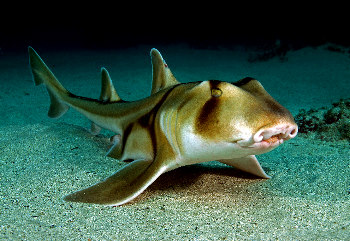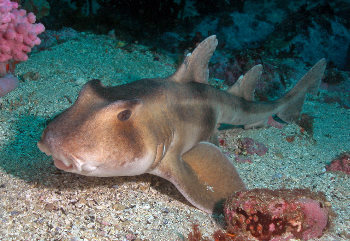Distribution
Found in Australia from southern Queensland down to Tasmania around to the southwest coast of Western Australia. Has also been recorded in New Zealand.
Found on the east coast of Australia and occurs from southern Queensland to southern NSW.
Morphology
Can be identified by the dark brown/black lines on its body that form a triangle above the pectoral fins. The dorsal fins of the Port Jackson are triangular and have good size dorsal spines.
The Crested Horn Shark can be distinguished by the dark blotch pattern that it has on its body and its gill slits are laterally in front of and above its pectoral fins. Its body colour is generally grey to brown and it has very high crests above its eyes.
Diet
Benthic invertebrates such as crabs and they use their teeth to crack and crush through the shells of crustaceans.
Size
Maximum length is 1.6m but usually seen less than 1m
Maximum length 1.2m
Fun Fact
Around winter time (June - August) it’s their mating season and large congregations of Port Jackson Sharks can be found on NSW coastal reefs in gutters and caves.
This species is more commonly seen in inshore estuaries than the Port Jackson Shark.
These sharks are oviparous meaning that they lay eggs with babies inside. The crested horn shark egg cases have curly tendrils that attach to aquatic plants and sponges whilst the Port Jackson eggs lack tendrils and their eggs are wedged into cracks and crevices.

